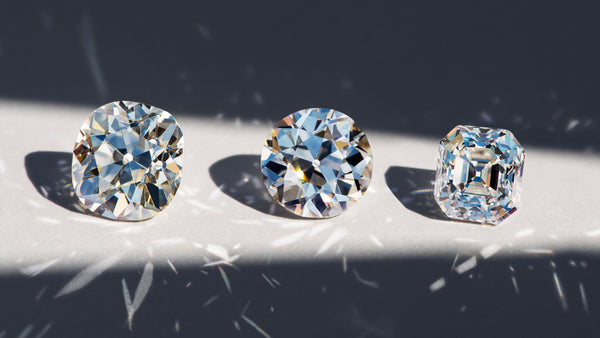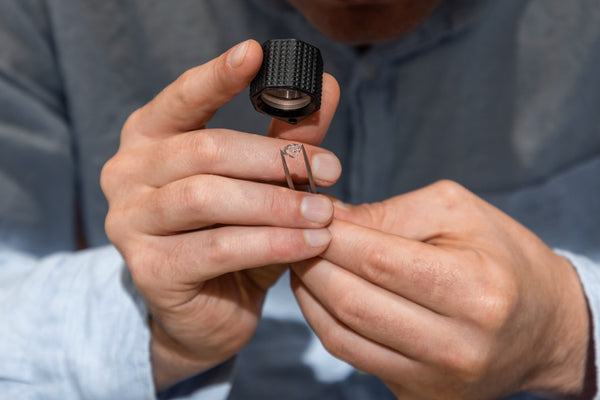The reasons to choose an antique diamond are plentiful. Antique diamonds not only have serious vintage appeal—they’re also eco-friendly. These one-of-a-kind beauties are steeped in history and brimming with unique character, making them an appealing choice at CUSHLA WHITING. But what is an antique diamond, exactly? What are the different antique cuts? And how do you know you’re looking at a genuine antique diamond? Read on to find out.
WHAT IS AN ANTIQUE DIAMOND?
Antique cut diamonds are diamonds that were mined and cut any time before 1930.
At CW we have a selection of genuine antique diamonds including Peruzzi, Old Mine, and Old European cuts, which were mined and cut by hand-eye between 1600 and 1930. These rare and enchanting diamonds have been hand-selected by our Gemologist Hamish from the famous Antwerp Diamond Bourse, a global centre for trading diamonds, both modern and antique.

AUTHENTIC ANTIQUES VS. MODERN "ANTIQUE-STYLE" CUTS.
Antique diamonds are not to be confused with “antique-style” cut diamonds. There are many companies around the world cutting modern diamonds in an antique style and marketing them as "antique diamonds" which is very misleading.
Modern cutting techniques can replicate—to some degree—the style of an antique cut, but most fall short in beauty. It’s usually very easy to differentiate a modern cut “antique-style” diamond from a genuine antique diamond. For example, modern cut antiques are generally still cut very shallow without the high crowns of old cuts (modern cut techniques favour weight retention, genuine antique cutting favoured beauty), and the machinery used to cut genuine antiques in the past was very different. Today, diamonds are cut by computers and laser technology. In the past, they were cut by hand by skilled artisans. Genuine antique cut diamonds have different, and more unique, qualities that are extremely difficult to replicate now.
KEY VISUAL CHARACTERISTICS OF GENUINE ANTIQUE DIAMONDS COMPARED TO MODERN CUT DIAMONDS:
- Less and larger facets, giving a softer look.
- A higher crown angle and smaller table facet giving more blocky light return as opposed to the very uniform, and "blingy" look of modern cut diamonds.
- More fire (light dispersion)
- Girdle finishing - thin/non-bruted girdle for Old Mine Cut diamonds in contrast to the thick faceted girdle on modern cut diamonds. Old European cut diamonds were cut after bruting was invented (1880 and onwards), whereas Old mine cut diamonds were cut before bruting and so have no girdle and natural rough left as a girdle.
- Larger “open culet”
- Generally “warmer” in colour: The majority of antique diamonds fall in the I-J-K colour grades or warmer. This is partly because most of the rough diamonds at that time came from mines that produced warmer-colored diamonds, and also because most of the colorless antique diamonds (grade D-H) have been recut over the years into modern brilliant diamonds. Higher colour grades do exist but they are much rarer and come at a premium
- Evidence of wear, Abrasions on facet edges

ANTIQUE DIAMONDS VS. MODERN CUT DIAMONDS:
HOW TO SPOT THE DIFFERENCE.
Here are some of the key visual differences to look out for.

TRUE BEAUTY IS PRICELESS.
Modern diamonds are cut for weight retention and price, not for beauty.
Genuine antique diamonds were cut by one cutter, artistically, and instinctually, all by hand-eye and the skill of the cutter, like a piece of art. Whereas, modern cut diamonds are now cut in assembly lines (mostly in India), aided by computers and scanning, rather than the artistic impression or skill of a single cutter. This evolution of diamond cutting into a factory line, and the commoditisation of diamonds, is what killed diamond cutting as an art. It became all about the "4 C's", the certificate, and the value, rather than the beauty of the diamond and artistic expression of the diamond cutter.
Each antique diamond has its own hidden story and unique character, the mark of the artist who cut it. However, just like how there are huge differences between the quality of art—it's the same for antique diamonds. There is a huge variation in skill and artistry between different antique diamonds—there were less-skilled cutters and also the "Picassos" of the time.


